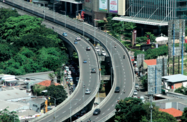With its low debt-to-GDP ratio, abundant resources, growing consumer demand, healthy political discourse and rising investment, Indonesia is set to lead the region and could become the world’s sixth-largest economy by 2030. But its bright future remains at risk due to bottlenecks that are the result of the lack of infrastructure and of the low quality of what is already in place. The government is working to address these problems, in part by encouraging public-private partnerships (PPPs).
Investment at relatively low levels
Infrastructure investment has lagged in recent years, averaging 3-4% of GDP since 2000, well down on the 7% or more from before the Asian financial crisis in the late 1990s. Moreover, others in the region are spending far more, with China, Thailand and Vietnam averaging around 7% of GDP over the past two decades. While recent years have seen some spikes, notably in 2009 and 2010, when infrastructure investment averaged close to 6% of GDP, spending has again fallen back to 4%.
The cost to the economy is likely significant. Insufficient infrastructure places burdens on existing businesses, which must deal with transport and logistics systems that are not equipped to handle current volumes, and communication networks that are outdated. The Indonesian Logistics Association has said the cost of logistics is equivalent to 24-27% of GDP, compared to 19-22% in other Asian countries. Inadequate infrastructure also discourages global businesses from setting up shop in Indonesia, as foreign investors look to more favourable environments.
According to a recent report on the Indonesia economy by the Qatar-based QNB Group, aging infrastructure is now holding back GDP growth by 3-4 percentage points each year. The bank has estimated that the economy will grow at 5% per year in the 2015-8 period, below trend, due to the poor state of infrastructure.
Plans to accelerate investment
The government is well-aware of the challenges that it faces and has proposed several plans to address infrastructural shortcomings. The National Medium‐Term Development Plan 2010-14 states that infrastructure investment will be focused on meeting basic needs and improving the competitiveness of Indonesian products. The central government estimated that the necessary investment over the 2010-14 period amounted Rp1923trn ($166.9bn), with some 70% to come from the private sector, PPPs, local governments and state-owned enterprises (SOEs).
However, perhaps the most significant driver behind infrastructure development will be the Master Plan for the Acceleration and Expansion of Indonesian Economic Growth 2011-25, or MP3EI, issued in 2011. This programme augments rather than replaces existing government initiatives, such as the National Medium-Term Development Plan. It is a more focused document, and one that places particular importance on infrastructure.
The government has estimated that a total Rp4012trn ($348.2bn) will be spent on MP3EI, with Rp1786trn ($155bn) allocated to infrastructure. The central government is expected to account for about 10% of funding, with 18% to come from SOEs, 51% from private enterprise and 21% from PPPs. Of the 79 MP3EI projects, 32 are set to be PPPs.
However, Indonesia’s goals could be difficult to achieve, and challenges in engaging the private sector in projects, a slow approval process, and problems over land acquisition have combined with other issues to delay the roll out of many of the government’s showcase developments.
According to Wishnu Wardhana, chair of APEC Business Advisory Council (ABAC) 2013 and group CEO of Indika Energy, the biggest obstacles are legal and regulatory, as well as coordination among institutions and the central and local governments. “We have been discussing PPP for a long time, yet progress has been limited. The public sector needs to address the regulatory environment. Infrastructure is a long-term investment, and businesses want to ensure that they will earn adequate return, and for that reason, issues such as legal certainty, risk environment and overall investment climate matter,” Wardhana told OBG. He added that many projects have been delayed, which has undermined overall confidence in the government and added to investor costs.
New momentum
The government is hoping to give the MP3EI added momentum, with the Ministry of National Development Planning and the Ministry of Economy having identified 27 priority projects that they intend to launch in 2014. These projects, with a combined price tag of $47.5bn and encompassing the full range of transport, utilities and communications sectors, are to be carried out as PPPs.
This is a positive development, suggesting that the government is committed to speeding up the provision of essential infrastructure. However, roll out of these projects will likely be a lengthy process, and while there are significant opportunities for investors and contractors, downside factors will have to be weighed carefully during the negotiation stages.
Follow Oxford Business Group on Facebook, Google+ and Twitter for all the latest Economic News Updates. Or register to receive updates via email.

